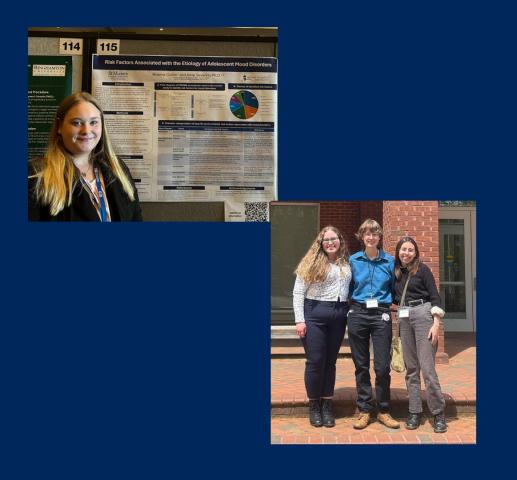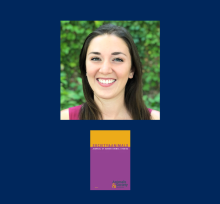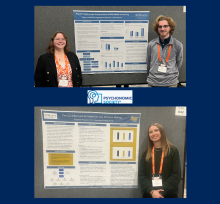
Four psychology majors presented research to outside audiences in April 2024. Alongside former SMCM Visiting Assistant Professor of Psychology Amie Severino ‘11 (now at Mount Saint Mary’s University), Briana Corbin ’24 presented at the Anxiety and Depression Association of America conference in Boston, MA. Gabrielle Blew ’24, Angelie Roche ’24 and Katya Scott ’24 presented their individual St. Mary’s Projects (all conducted under the mentorship of Professor of Psychology Libby Nutt Williams) at the L. Starling Reid Undergraduate Psychology Conference held at the University of Virginia in Charlottesville, VA on April 26.
Corbin’s poster, “Risk Factors Associated with the Etiology of Adolescent Mood Disorders,” was based on work conducted as part of her 2023 Summer Undergraduate Research Fellowship (SURF) project with Severino. Abstract: Risk factors in a young person’s environment can lead to the expression of mood disorders such as anxiety and depression in adolescence. These mental health disorders often lead to detrimental psychosocial and academic impacts during adolescence and may persist throughout adulthood. It is important to identify the risk factors of adolescent mood disorders to allow for the implementation of early interventions. We implemented a rigorous methodological strategy to synthesize the existing evidence of environmental risk factors for anxiety and depression of adolescents in the United States (age 13-19) from quantitative, empirical sources that were published in the last 10 years (2013-2023) in peer-reviewed journals. After reviewing 29 articles from an initial search query of 16,363 articles, we identified common themes of risk factors associated with the development of anxiety and depression in adolescence. These themes were trauma, factors relating to the neighborhood and community the youth resided in, negative life events, victimization, peer rejection, factors related to the income level of the youths' environment, discrimination, family factors, and substance use. Only one of the 29 studies examined puberty as an indication of adolescence. Additionally, a few studies indicated the interaction of mood disorders with biological implications, such as anxiety being associated with sleep disturbances. Understanding how to effectively address these identified risk factors is essential to clinical interventions for adolescent mood disorders and the potential life-long biological consequences.
Blew presented a poster entitled “To Gift or Not to Gift: Examining the Impact of Telehealth on Client Gift Giving.” Abstract: Gift-giving is an ethical dilemma in psychotherapy, often discussed by many psychotherapists. There is no clear answer on how therapists should respond when they are presented with a gift by a client, which is likely due to the controversy of gift-giving within psychotherapy more broadly. There is a lack of understanding of how other morally gray areas of psychology, such as the introduction of telehealth, have impacted the overall issue of client gift-giving. Zoom interviews were conducted to better understand therapists’ views and experiences with client gift-giving, and how their experiences differed between in-person and telehealth settings. Eight therapists who had been practicing for a minimum of five years, have provided telehealth services and who have been offered at least one gift by a client were interviewed. These interviews were analyzed using Consensual Qualitative Research methods (Hill, Thompson, & Williams, 1997; Hill et al., 2005). Major findings include that only four of the eight therapists had received gifts while seeing clients via telehealth, with these gifts usually being delivered through electronic means. Additionally, most of these therapists had only one experience where a telehealth client had attempted to give them a gift. Typically, the therapists felt like gift-giving is less prevalent via telehealth, which may be related to how it fosters a less personal relationship. Overall, these results suggest that telehealth may have minimized the ethical dilemma of gift-giving within the realm of psychotherapy.
Roche presented a poster entitled “Summer Camp Counselor Experiences: The Influence of Training, Self-Efficacy, and Organizational Cohesion.” Abstract: Many overnight camps use Counselor-in-Training (CIT) programs to prepare adolescent campers for the counselor role. Although research has investigated the efficacy of individual CIT programs, studies have not compared the experiences of previous CITs to the experiences of new, non-CIT counselors across camp types. We recruited 314 camp counselors (130 previous CITs and 185 non-CITs) from camps across the US and Canada for an online survey assessing their self-efficacy and organizational cohesion (Chen et al., 2001; Ruga, 2014) and other items related to their experiences as first-year counselors. The majority of the sample reported positive experiences. Although CIT completion did not correlate significantly with any variable, individual and camp factors such as job fit, satisfaction with training and comfort talking to administrators correlated with self-efficacy and organizational cohesion. More between-camps research is needed to examine training, overall climate and the true efficacy of CIT programs.
Scott presented a talk entitled “Art Therapy with Ukrainian Refugees: A Pilot Program”. Abstract: There is little empirical research available that explores art therapy with adult refugees. Refugees face increased risk for mental health conditions such as depression, anxiety, and post-traumatic stress disorder; post-migration, they also often face challenges such as cultural isolation and a loss of community. As the number of refugees worldwide increases at an alarming rate, well-researched, culturally sensitive systems of mental health support must be made available to anyone who requires them. Group art therapy may be a particularly helpful intervention due to a focus on social connections and a de-emphasis on verbal processing, which might help lessen the impact of language barriers and support those with difficulty expressing painful experiences in words. To ensure programs are culturally sensitive, adopting the Multicultural Orientation (MCO) framework is an ideal approach. Current research on art therapy with refugees is extremely limited, particularly with adults. However, incorporating culturally significant materials into art therapy programs may be a promising route for future work. To address this gap in research, we conducted a mixed-methods study of a five-week group art therapy program incorporating culturally significant materials with adult Ukrainian refugees. Via pre- and post-intervention surveys, we analyzed the program’s potential influence on anxiety, resilience, and connection to community. We also conducted brief interviews with participants about their experiences in the program and analyzed these using Consensual Qualitative Research (CQR). The results offer potential directions for research in this area that should be further explored in future studies.
For her SMP work, Katya Scott was presented with the Myron G. Marlay Award for Science at this year's Awards Convocation. Angelie Roche was selected as one of two winners of the 2024 Department of Psychology's SMP Award.



